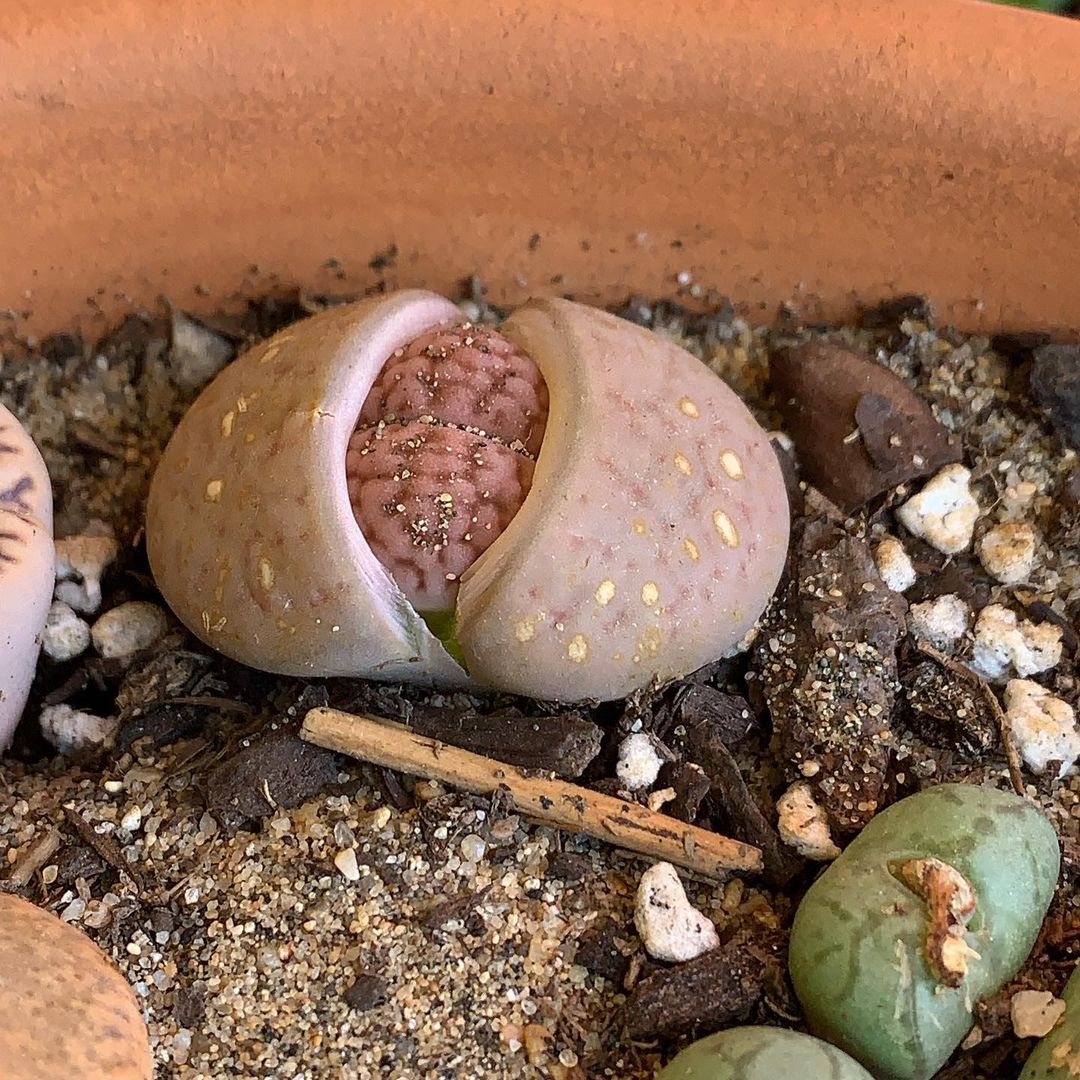Lithops
Posted by Grace on April 13, 2023
Lithops. Lithops. Lithops. They are my favorite. I have a lot to talk about.
Note: I also created a Lithops identification guide here 😊. Check it out!
 My collection of Lithops: Lithops otzeniana (the green one), Lithops terricolor (the pink with dark spots), Lithops aucampiae (the brown one)
My collection of Lithops: Lithops otzeniana (the green one), Lithops terricolor (the pink with dark spots), Lithops aucampiae (the brown one)
Quick Facts
- Native Habitat: Southern Africa, particularly in regions such as Namibia, South Africa, and Botswana.
- Family: Aizoaceae
- Water: Lithops are adapted to arid environments and store water. They prefer dry climates and should be watered sparingly, especially during dormancy in summer. Avoid overwatering to prevent rot.
- Sunlight: Lithops thrive in bright, indirect sunlight, partial to full sunlight depending on the species. They can tolerate some shade during the hottest part of the day.
- Soil: Lithops like well-draining soil, mimicking their natural rocky or sandy habitat. Avoid heavy, water-retentive soils to prevent root rot.
- No such thing called Lithop: Lithops is both a singular and a plural. 1 Lithops, and 2 Lithops. Also, we capitalize L for Lithops. No lithops.
Why it is called Lithops?
The name "Lithops" comes from the Greek words "lithos" which means "stone" and "ops" which means "face". This name refers to the plant's unique appearance, which resembles small stones or pebbles with a slit-like opening on the top that resembles a pair of eyes.
Lithops are also commonly known as "living stones" or "flowering stones" due to their distinct appearance.
The Appearance of Lithops
Lithops are small, low-growing succulent plants that typically have a body made of two fleshy leaves that are fused together, forming a cleft or slit-like opening on the top.
The top surface of the leaves is usually flat or slightly convex, and can come in various colors and patterns, mimicking the appearance of stones or pebbles.
When Lithops are in bloom, they produce small daisy-like flowers in various colors, such as white, yellow, pink, or orange.

Care for Lithops
Lithops are relatively low-maintenance plants, but they do require some specific care to thrive. Here are some general care guidelines for Lithops:
Light: Lithops prefer bright, indirect sunlight. They should be placed in a location that receives partial to full sunlight, depending on the species. Avoid placing them in intense, direct sunlight as it can scorch their leaves.
Water: Lithops have a unique water-storing adaptation and should be watered sparingly. Water them only when the soil is completely dry and avoid overwatering, as it can cause the plant to rot. During their dormant period, which typically occurs during the summer months, they require even less water.
Soil: Lithops prefer well-draining soil mix that mimics their natural habitat, such as sandy or gravelly soils. Avoid heavy, water-retentive soils, as they can cause root rot.
Temperature: Lithops prefer warm to hot temperatures during their growing season, typically from spring to fall, and cooler temperatures during their dormant period. They can tolerate a wide temperature range but should be protected from frost.
Container: Lithops are typically grown in containers that provide good drainage, such as clay pots or shallow trays, to prevent excess moisture around the roots.
Read more about my secrets for caring for Lithops.

Propagation of Lithops
Lithops can be propagated through seeds or by division. Propagating Lithops from seeds can be challenging, as they have specific germination requirements, such as a period of stratification (cold treatment) and a well-draining seedling mix.
Division is the more common method of propagation, where the mature plant forms new offsets or "pups" that can be carefully separated and replanted.
Where to Find Lithops?
Lithops can be found in various nurseries, specialty succulent stores, or online plant shops. They are popular among succulent enthusiasts and collectors, and their unique appearance makes them sought-after plants for many plant enthusiasts.
It's important to check the legality of importing or exporting Lithops if you are purchasing them internationally, as they may be subject to certain regulations or restrictions.
Read more about where to buy Lithops.
FAQ
What are Cole Numbers?
"Cole Numbers" refer to a labeling system used by Desmond and Naureen Cole, enthusiasts of succulent plants, specifically Lithops. They marked Lithops seeds with a 'C' to denote their ownership or association. Despite their non-botanical backgrounds (Desmond was a linguist, Naureen a pharmacist), they devoted themselves to studying and collecting succulents, eventually focusing exclusively on Lithops. Their significant contributions include the book "Lithops, flowering stones," and many Lithops seeds on the market bear their 'C' mark, reflecting the Coles' involvement.
For example, C001 is Lithops lesliei subsp. lesliei var. venteri.
You can find the full list of Cole Numbers here.






